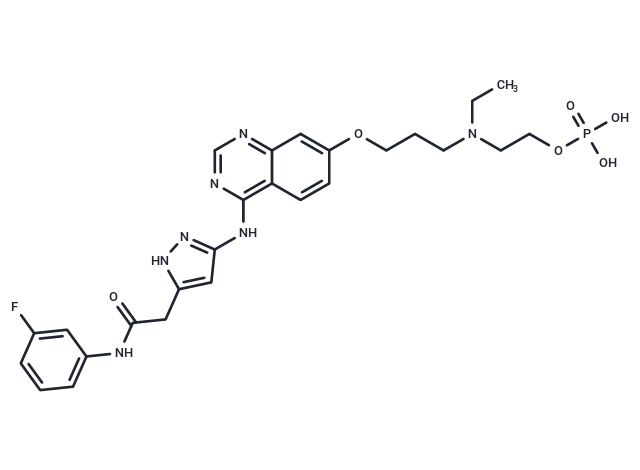Shopping Cart
- Remove All
 Your shopping cart is currently empty
Your shopping cart is currently empty

AZD1152 is a pro-drug of Barasertib (AZD1152)-hQPA. Which is a highly selective Aurora B inhibitor with IC50 of 0.37 nM in a cell-free assay.

| Pack Size | Price | Availability | Quantity |
|---|---|---|---|
| 2 mg | $42 | In Stock | |
| 5 mg | $68 | In Stock | |
| 10 mg | $118 | In Stock | |
| 25 mg | $219 | In Stock | |
| 50 mg | $386 | In Stock | |
| 1 mL x 10 mM (in DMSO) | $89 | In Stock |
| Description | AZD1152 is a pro-drug of Barasertib (AZD1152)-hQPA. Which is a highly selective Aurora B inhibitor with IC50 of 0.37 nM in a cell-free assay. |
| Targets&IC50 | Aurora B:0.37 nM |
| In vitro | Barasertib inhibits the proliferation of hematopoietic malignant cells such as HL-60, NB4, MOLM13, PALL-1, PALL-2, MV4-11, EOL-1, THP-1, and K562 cells with IC50 of 3-40 nM, displaying appr 100-fold potency than another Aurora kinase inhibitor ZM334739 which has IC50 of 3-30 μM and it also inhibits the clonogenic growth of MOLM13 and MV4-11 cells with IC50 of 1 nM and 2.8 nM, respectively, as well as the freshly isolated imatinib-resistant leukemia cells with IC50 values of 1-3 nM, more significantly compared with bone marrow mononuclear cells with IC50 values of >10 nM. Barasertib displays >3000-fold selectivity for Aurora B as compared with Aurora A which has an IC50 of 1.368 μM. Barasertib causes significant accumulation of cells with 4N/8N DNA content in KMS12 and U266 and induces apoptosis in KMS18 and U266. Barasertib has even less activity against 50 other serine-threonine and tyrosine kinases including FLT3, JAK2, and Abl. Barasertib induces accumulation of cells with 4N/8N DNA content, followed by apoptosis in a dose- and time-dependent manner[1]. Barasertib in combination with DEX, has negative effects on cell viability in comparison with single agent in PMI8226, KMS11 and U266[3]. |
| In vivo | Administration of Barasertib (25 mg/kg) alone markedly suppresses the growth of MOLM13 xenografts, confirmed by the observation of necrotic tissue with infiltration of phagocytic cells[1]. Barasertib (25 mg/kg/day) treatment reduces xenograft levels such that they are slightly lower levels than after the first round of treatment, but this is not statistically significant indicating that residual cells might be more resistant to a second cycle of Barasertib[4]. In addition, Barasertib (10-150 mg/kg/day) significantly inhibits the growth of a variety of human solid tumor xenografts, including colon, breast, and lung cancers, in a dose-dependent manner[2]. |
| Alias | AZD1152 |
| Molecular Weight | 587.54 |
| Formula | C26H31FN7O6P |
| Cas No. | 722543-31-9 |
| Smiles | CCN(CCCOc1ccc2c(Nc3cc(CC(=O)Nc4cccc(F)c4)[nH]n3)ncnc2c1)CCOP(O)(O)=O |
| Relative Density. | 1.463 g/cm3 |
| Storage | Powder: -20°C for 3 years | In solvent: -80°C for 1 year | Shipping with blue ice. | ||||||||||||||||||||||||||||||
| Solubility Information | DMSO: 33 mg/mL (56.17 mM), Sonication is recommended. | ||||||||||||||||||||||||||||||
Solution Preparation Table | |||||||||||||||||||||||||||||||
DMSO
| |||||||||||||||||||||||||||||||

Copyright © 2015-2025 TargetMol Chemicals Inc. All Rights Reserved.